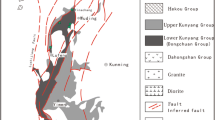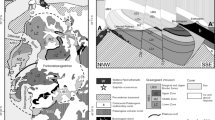Summary
The New Norcia and the Yornup bodies are situated within the high-grade Western Gneiss Terrain of the Yilgarn Block. The New Norcia body consists of mafic and ultramafic rocks of gabbronoritic, olivine-gabbronoritic and harzburgitic composition respectively, metamorphosed to amphibolite, amphibolitic serpentinite and serpentinite.
The upper part of the body is conformably intercalated with quartzites and minor psammites.
The Yornup body consists of an ultramafic zone, mainly of lherzolitec and harzburgitic and minor dunitic composition and a mafic zone of olivine-gabbronorite, which has partly been differentiated.
Chondrite-normalized PGE patterns of lherzolites and harzburgites from both localities show gentle, positive trends and abundances of approximately 0.01 times C 1. Patterns of sulphide-bearing rocks are about 0.1 times C 1, with Pd strongly enriched.
The flat patterns suggest that the magma was derived from high degrees of partial melting and underwent only minor differentiation.
Mobilization of sulphides fractionated the PGE and particularly enriched palladium.
The patterns resemble those of komatiites and komatiite-related nickel sulphides. They are distinct from steep positively trending patterns characteristic of Archean tholeiites.
It is assumed that prior to the main metamorphic event, magma compositionally similar to that of komatiites intruded at the contact of a protocontinental basement and overlying sediments forming sill-shaped bodies.
Zusammenfassung
Die Lokalitäten New Norcia and Yornup befinden sich im hochmetamorphen Teil des Yilgarn-Blockes, dem Western Gneiss Terrain.
Die New Norcia Abfolge besteht aus Amphiboliten und amphibolitischen Sepentiniten mit gabbronoritischer und olivin-gabbronoritischer sowie aus Serpentiniten mit harzburgitischer Zusammensetzung. Im Hangenden sind die Amphibolite mit Quarziten und Psammiten verzahnt.
Lherzolite, Harzburgite und untergeordnet auch Dunite bilden den ultramafischen Teil der Yornup-Abfolge, deren mafische Einheit aus Amphiboliten gabbronoritischer bis olivin-gabbronoritischer Zusammensetzung besteht und in einem Teil Differentiation zeigt.
Chondrit-normalisierte PGE Verteilungsmuster von Lherzoliten und Harzburgiten beider Lokalitäten zeigen einen schwach positiven Trend von Iridium zu Gold; die PGE-Gehalte sind ca. 0.01 fach chondritisch. Die PGE-Gehalte sulfidhaltiger Gesteine sind ca. 0.1 fach chondritisch und zeigen starke Palladium-Anreicherungen.
Aus dem flachen Verlauf der PGE-Kurven wird auf einen hohen Aufschmelzungsgrad und nur unbedeutende Differentiation geschlossen. In den mobilisierten Sulfiden fand eine Fraktionierung der PGE statt und führte insbesondere zu einer starken Anreicherung des Palladiums.
Die PGE-Kurven sind denen von Komatiiten und den mit diesen assoziierten Nickelsulfiden ähnlich und unterscheiden sich deutlich von steilen Kurven archaischer Tholeiite.
Es wird angenommen, daß vor der metamorphen Überprägung des WGT ein in der Zusammensetzung Komatiiten ähnelndes Magma zwischen einem protokontinentalen Basement und daraufliegenden Sedimenten intrudierte und sillförmige Körper bildete.
Similar content being viewed by others
References
Anhaeusser CR (1984) Structural elements of Archean granite greenstone terraines as exemplified by the Barberton Mountainland, Southern Africa. In:Kröner A, Greiling R (eds) Precambrian tectonics illustrated. Schweizerbart'sche Verlagsbuchhandlung, Stuttgart, pp 55–78
Arndt NT, Nisbet EG (1982) What is komatiite? In:Arndt NT, Nisbet EG (eds) Komatiites. Allen & Unwin, London, pp 19–27
Barnes SJ, Naldrett AJ, Gorton MP (1985) The origin of the fractionation of platinum-group elements in terrestrial magmas. Chem Geol 53: 303 324
Condie KC (1981) Archaean greenstones. Developments in Precambrian geology. Elsevier 3, 434 pp
Donaldson MJ, Lesher CM, Groves DI, Gresham JJ (1986) Comparison of Archean dunites and komatiites associated with nickel mineralization in Western Australia: implications for dunite genesis. Miner Dep 21: 296–305
Duke JM (1986) The Dumont nickel deposit: a genetic model for disseminated magmatic sulphide deposits of komatiitic affinity. In:Gallagher MJ et al (eds) Metallogeny of basic and ultrabasic rocks. Inst Mining Metall London, 151–160
Fryer BJ, Kerrich R (1978) Determination of precious metals at ppb-levels in rocks by a combined wetchemical and flameless atomic absorption method. Atomic absorption newsletter 17: 4–60
Gee RD (1979) Structure and tectonic style of the Western Australian Shield. Tectonophysics 58:327–369
——Trendall AF (1986) Relation between Archaean high-grade gneiss and granitegreenstone terrain in Western Australia. Precam Res 33: 87–102
Gijbels R, Henderson P, Zels J (1976) Geochemistry of some trace elements in mineral separates from Rhum, Inner Hebrides, with special emphasis on iridium. Econ Geol 71: 1364–1370
Glikson AY (1979) Early Precambrian tonalite-trondhjemite sialic nuclei. Earth Sci Rev 15: 1–73
Harrison PH (1984) The mineral potential of layered igneous complexes within the Western Gneiss Terrain. In: Professional papers for 1984 of the Geol Surv of W. A. 19. Gov Printing Office, Perth, pp 37–54
Keays RR (1982) Palladium and iridium in komatiites and associated rocks: application to petrogenetic problems. In:Arndt TN, Nisbet EG (eds) Komatiites. Allen & Unwin, London, pp 435–458
Keays RR, Campbell IH (1981) Precious metals in the Jimberlana Instrusion, Western Australia: Implications for the genesis of platiniferous ores in layered intrusions. Econ Geol 76: 1118–1141
——,Ross JR, Woolrich P (1981) Precious metals in volcanic peridotite-associated nickelsulphide deposits in Western Australia II. Econ Geol 76: 1645–1674
Kruse H, Spettel B (1982) A combined set of automatic and interactive programs for instrumental neutron activation analysis. J Radioanalytical Chem 70: 427–434
Lee CA, Tredoux M (1986) Platinum-group element abundances in the Lower and the Lower Critical Zones of the Eastern Bushveld Complex. Econ Geol 81: 1087–1095
Mitchell RH, Keays RR (1981) Abundance and distribution of gold, palladium and iridium in some spinel and garnet lherzolites-implications for the nature and origin of precious metal-rich intergranular components in the upper mantle. Geochim Cosmochim Acta 45: 2425–2442
Morgan WR (1984) The harzburgite member of an ultramafic body in granulites, Lake Kondinin, Western Australia. J Roy Soc W A 66, part 4, 135–145
—— (1982) A layered ultramafic intrusion in Archaean granulites near Lake Kondinin, Western Australia. J Roy Soc W A 65, part 2, 69–85
Myers JS, Williams JR (1985) Early Precambrian crustal evolution at Mount Narryer, Western Australia. Precambrian Res 27: 153–163
Naldrett AJ (1981) Nickel sulfide deposits: classification, composition and genesis. Econ Geol 75: 628–655
——,Barnes SJ (1986) The behaviour of platinum group elements during fractional crystallization and partial melting with special reference to the composition of magmatic sulfide ores. Fortschr Mineralogic 64: 113–133
Page NJ, Cassard D, Haffty J (1982) Palladium, Platinum, Rhodium, Ruthenium and Iridium in Chromitites from the Massif du Sud and Tie6aghi Massif, New Caledonia. Econ Geol 77: 1571–1577
Palme H, Suess HE, Zeh DH (1981) Abundances of the elements in the solar system. In:Landolt-Börnstein, New Series VI/2 a, Springer, Berlin Heidelberg New York, p 257
Porter DJ, McKay KG (1981) The nickel sulphide mineralization and metamorphic setting of the Forrestania area, Western Australia. Econ Geol 76: 1524–1549
Ross JR, Keays RR (1979) Precious metals in volcanic-type nickel sulphide deposits in Western Australia, I. Relationship with the composition of the ores and their host rocks. Can Mineral 17: 417–435
Shackleton RM (1976) Shallow and deep level exposures of the Archaean crust in India and Africa. In:Windley BF (ed) Early history of the earth. Wiley, London, pp 317–322
Stumpf, EF (1986) Distribution, transport and concentration of platinum group elements. In:Gallagher MJ et al (eds) Metallogeny of basic and ultrabasic rocks. Inst Mining Metall, London, 379–394
Sun SS (1982) Chemical composition and origin of the earth's primitive mantle. Geochim Cosmochim Acta 46: 179–192
Wänke H, Kruse H, Palme H, Spettel B (1977) Instrumental neutron activation analysis of Lunar samples and the identification of primary matter in the Lunar highlands. Radioanalytical Chem 38: 363–378
Weaver BL, Tarney J (1981) Lewisian gneiss geochemistry and Archaean crustal development models. Earth Planet Sci Lett 55: 171–180
Windley BF, Bridgewater D (1971) The evolution of Archaean low and high-grade terrains. Geol Soc Austr Spec Publ 3: 33–46
Wilde SA (1974) Explanatory notes on the Archaean rocks on the Perth 1 : 250 000 geological sheet, Western Australia. West Australia Geol Survey Rec 1974/15
—Walker JW (1981) Explanatory notes on the Pemberton-Irwin Inlet 1 : 250 000 geological sheet. West Australia Geol Survey Rec 1981/10
——,Pidgeon RT (1986) Geology and geochronology of the Saddleback greenstone belt in the Archaean Yilgarn block. Australian Journal of Earth Sciences 33 (4): 491–502
Author information
Authors and Affiliations
Additional information
With 8 Figures
Contribution to the Ore Mineralogy Symposium (IMA/COM) at the 14th General Meeting of the International Mineralogical Association, at Stanford, California, in July, 1986.
Rights and permissions
About this article
Cite this article
Cornelius, M., Stumpfl, E.F., Gee, D. et al. Platinum group elements in mafic-ultramafic rocks of the Western Gneiss Terrain, Western Australia. Mineralogy and Petrology 36, 247–265 (1987). https://doi.org/10.1007/BF01163263
Received:
Accepted:
Issue Date:
DOI: https://doi.org/10.1007/BF01163263




